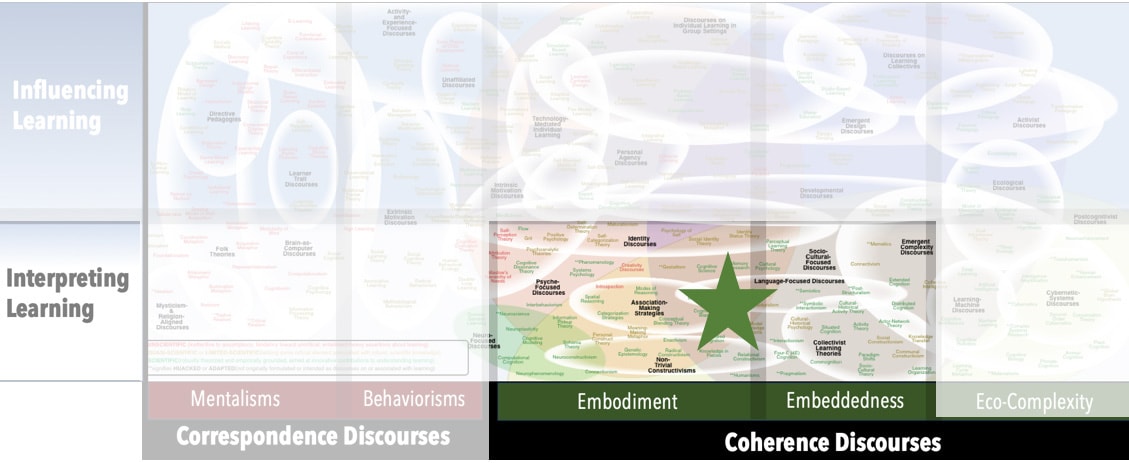Focus
How individuals understand themselves in social contextsPrincipal Metaphors
- Knowledge is … scope of possible actions and interpretations
- Knowing is … acting; self-perception
- Learner is … an actor (in a social context)
- Learning is … self-becoming
- Teaching is … influencing
Originated
1920sSynopsis
Interactionism focuses on meaning that arises in face-to-face social interactions as it studies how individuals shape and are shaped by society. Interactionism is especially interested in understanding individuals – that is, how they act and how they see themselves in their social contexts. Social interaction is understood to include all language, gestures, and mannerisms, and it is seen have the goal of communication with others.Commentary
With its focus on the individual and its interest in social context, Interactionism is described by some as sitting between Phenomenology and Social Constructionism. That positioning might be seen as a strength, but in many critical commentaries it is targeted as a weakness. For example, whereas social class is a major consideration within Social Constructionism, it can be considered unimportant in some studies oriented by Interactionism – simply because generalizations based on large groups of people cannot be assumed of or imposed on individuals under study. Notably, Interactionism serves as a background discourse within many perspectives discussed on this site – that is, the defining principles of Interactionism have come to be assumed by most contemporary theories concerned with social and cultural action. As well, although not a core theme of Interactionism, the discourse is frequently encountered in discussions of the learning and manifestation of aggressive, deviant, and criminal behavior. For example, associated discourses (listed chronologically) include:- Social Disorganization Theory (Chicago School of Sociology, 1920s) – a theory about criminality that suggests that the weakening of traditional social bonds – that is, the emergence and prevalence of unhealthy family and community interactions – contributes to social disintegration, a principal manifestation of which is crime
- Differential Association Theory (Edwin Sutherland, 1930s) – a theory about criminality that suggests the values, attitudes, tactics, and motivations for criminal behavior are learned through interactions with others
- Cultural Deviance Theory (Walter Miller, 1950s) – a theory about criminality that suggests it has little to do with innate character traits and almost everything to do with the characters one encounters, the place one lives, and the socio-economic conditions of one’s existence
- Excitation-Transfer Theory (Dolf Zillmann, 1970s) – a perspective on aggressive behavior that is focused on media representations of violence, founded on the principle that exposure to such representations will arouse viewers and that that arousal can intensify negative emotions and their associated actions
- Interactional Theory (Terence Thornberry, 1980s) – a theory about the causes and consequences of antisocial behavior that suggests delinquent behavior can be attributed to weak social bonds, participation in delinquent networks, and feedback effects that amplify antisocial behavior while reinforcing identifications with deviant activities and social networks
- Self-Control Theory (General Theory of Crime) (Michael Gottfredson, Travis Hirschi, 1990s) – the hypothesis that lack of self control is the primary cause of criminal and deviant behavior. The root of poor self-control is suggested to be ineffective parenting, and it is surmised to be in place by age 8.
- Cyberbullying (various, 2000s) – bullying (i.e., harassing, intimidating, etc.) through a digital medium (e.g., texting or social networking)
- General Aggression Model (Craig Anderson, Brad Bushman, 2000s) – a perspective on aggressive behavior that draws on a variety of learning theories as it incorporates a range of biological, psychological, social, and cultural variables
- Cognitive-Neoassociation Theory of Aggression (Negative Affect Theory) (Leonard Berkowitz, 2010s) – a perspective on aggressive feelings and behaviors that looks across a range of influences (e.g., weather conditions and other unpleasant circumstances) and experiences (e.g., behaviors modeled by others)
Authors and/or Prominent Influences
George Herbert MeadStatus as a Theory of Learning
Interactionism is a theory of learning, with a particular focus on social influences on individual identity.Status as a Theory of Teaching
Interactionism is not a scientific theory of teaching, although the interactive structure of the teacher–student relationship is a common focus of researchers oriented by Interactionism.Status as a Scientific Theory
Interactionism is both a theoretical and a methodological discourse. Regard the latter, it was among the perspectives that helped pave the way to research methods in the human and social sciences that did not rely on measurement and replication. Interactionism meets our criteria of a scientific theory.Subdiscourses:
- Cognitive-Neoassociation Theory of Aggression (Negative Affect Theory)
- Cultural Deviance Theory
- Cyberbullying
- Differential Association Theory
- Excitation-Transfer Theory
- General Aggression Model
- Interactional Theory
- Self-Control Theory (General Theory of Crime)
- Social Disorganization Theory
Map Location

Please cite this article as:
Davis, B., & Francis, K. (2023). “Interactionism” in Discourses on Learning in Education. https://learningdiscourses.com.
⇦ Back to Map
⇦ Back to List
